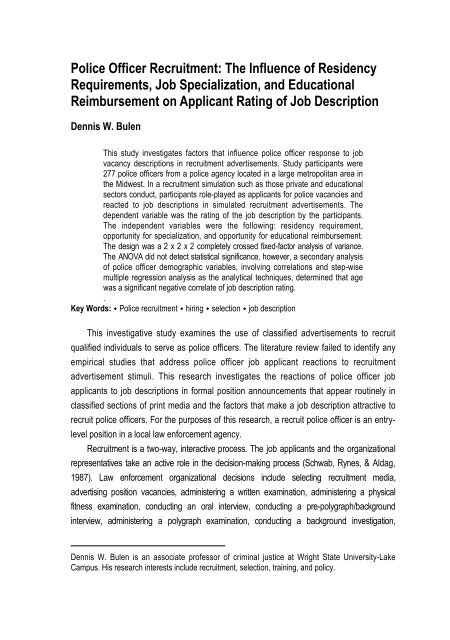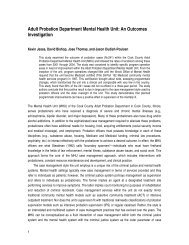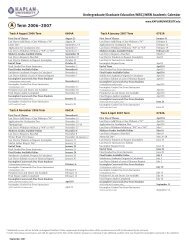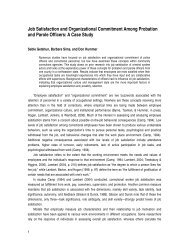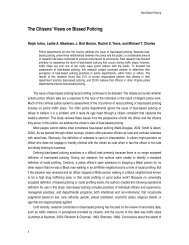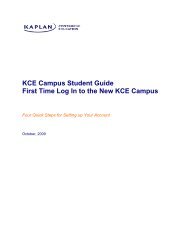Police Officer - Kaplan University | KU Campus
Police Officer - Kaplan University | KU Campus
Police Officer - Kaplan University | KU Campus
Create successful ePaper yourself
Turn your PDF publications into a flip-book with our unique Google optimized e-Paper software.
<strong>Police</strong> <strong>Officer</strong> Recruitment: The Influence of Residency<br />
Requirements, Job Specialization, and Educational<br />
Reimbursement on Applicant Rating of Job Description<br />
Dennis W. Bulen<br />
This study investigates factors that influence police officer response to job<br />
vacancy descriptions in recruitment advertisements. Study participants were<br />
277 police officers from a police agency located in a large metropolitan area in<br />
the Midwest. In a recruitment simulation such as those private and educational<br />
sectors conduct, participants role-played as applicants for police vacancies and<br />
reacted to job descriptions in simulated recruitment advertisements. The<br />
dependent variable was the rating of the job description by the participants.<br />
The independent variables were the following: residency requirement,<br />
opportunity for specialization, and opportunity for educational reimbursement.<br />
The design was a 2 x 2 x 2 completely crossed fixed-factor analysis of variance.<br />
The ANOVA did not detect statistical significance, however, a secondary analysis<br />
of police officer demographic variables, involving correlations and step-wise<br />
multiple regression analysis as the analytical techniques, determined that age<br />
was a significant negative correlate of job description rating.<br />
.<br />
Key Words: ! <strong>Police</strong> recruitment ! hiring ! selection ! job description<br />
This investigative study examines the use of classified advertisements to recruit<br />
qualified individuals to serve as police officers. The literature review failed to identify any<br />
empirical studies that address police officer job applicant reactions to recruitment<br />
advertisement stimuli. This research investigates the reactions of police officer job<br />
applicants to job descriptions in formal position announcements that appear routinely in<br />
classified sections of print media and the factors that make a job description attractive to<br />
recruit police officers. For the purposes of this research, a recruit police officer is an entrylevel<br />
position in a local law enforcement agency.<br />
Recruitment is a two-way, interactive process. The job applicants and the organizational<br />
representatives take an active role in the decision-making process (Schwab, Rynes, & Aldag,<br />
1987). Law enforcement organizational decisions include selecting recruitment media,<br />
advertising position vacancies, administering a written examination, administering a physical<br />
fitness examination, conducting an oral interview, conducting a pre-polygraph/background<br />
interview, administering a polygraph examination, conducting a background investigation,<br />
Dennis W. Bulen is an associate professor of criminal justice at Wright State <strong>University</strong>-Lake<br />
<strong>Campus</strong>. His research interests include recruitment, selection, training, and policy.
Bulen<br />
administering a psychological suitability screening, conducting a medical examination, and<br />
accepting an employment recommendation from the screening committee. Recruitment<br />
decisions job applicants make include deciding to apply for a vacancy, applying for the<br />
job, participating in each phase of the screening process, and accepting a job offer. Both<br />
the job applicant and the organizational representatives must make affirmative decisions<br />
for the hiring process to be successful.<br />
<strong>Police</strong> <strong>Officer</strong> Recruitment<br />
The ability of a police organization to provide optimal police service to the community<br />
depends on its ability to recruit personnel who are equipped to cope with the increasingly<br />
complex demands of the police occupational role.<br />
Administrators are well aware that the most important resource within any criminal<br />
justice agency is the personnel. Recruiting qualified officer candidates is a key element in<br />
building an effective and successful law enforcement agency (Bennett & Hess, 1996).<br />
During the cycling of personnel within an organization, members will terminate their<br />
employment for a variety of reasons. The replacement of departing personnel must<br />
become a top priority for agency success. Through the adoption of a meaningful<br />
recruitment plan, it will be much easier to attract the right type and quality of criminal<br />
justice personnel to contribute to the organization’s growth. Rowe (1985) suggests:<br />
In view of the growing sociopolitical importance and complexity of the<br />
service role, police administrators must seek-out and actively recruit<br />
those people who are best suited to a police career. In order to achieve<br />
this aim, the traditionally passive recruiting practices of many police<br />
agencies require drastic change (p. 37).<br />
Gaines, Kappeler, and Vaughn (1997) defined police recruitment as “the development<br />
of a pool of sufficiently qualified applicants from which to select officers” (p. 75). The<br />
number and quality of persons in the applicant pool depend in part on the department’s<br />
recruitment efforts. A more active effort is likely to produce a larger applicant pool with<br />
more qualified applicants. Departments take a variety of approaches in recruiting suitable<br />
police officer candidates. Strandberg (1996) touted the benefits of implementing various<br />
types of recruiting techniques that address the changing demographics of law<br />
enforcement candidates. McKay (1996) found that 95% of survey respondent departments<br />
used the newspaper as the primary information source for recruitment.<br />
Recruitment research in criminal justice has focused primarily on the effectiveness<br />
and reliability of traditional selection methods such as a written examination, an oral<br />
interview, and a psychological assessment. <strong>Police</strong> officer candidates who fail to meet a<br />
70 Professional Issues in Criminal Justice Vol 4(3 & 4), 2009
<strong>Police</strong> <strong>Officer</strong> Recruitment<br />
satisfactory rating on a traditional selection method were dropped from the process and<br />
not recruited by the police agency. The author found no empirical recruitment research<br />
that focused on applicant reactions to particular recruitment message content. Literature<br />
focuses only on segments of the selection process that occur after the applicant has<br />
decided to apply for employment.<br />
The difficulties of hiring qualified police officers have been well documented. <strong>Police</strong><br />
administrators themselves have expressed concern regarding increased recruiting problems.<br />
As a result, many police agencies are significantly below their authorized strength.<br />
Stone and Deluca (1994) found attracting qualified applicants for police vacancies “has<br />
become increasingly difficult and will only get more difficult in the future” (p. 267).<br />
Bowers (1989) identifies three primary reasons for increased recruitment problems:<br />
(a) the increased demand for police officers, (b) the appeal for racially representative<br />
police departments, and (c) a decline in the number of law enforcement applicants. These<br />
variables represent significant hiring problems for police administrators.<br />
One goal of any recruitment program is attracting an applicant pool that is diverse<br />
enough to meet the organization’s objectives. But recruiting qualified police officer candidates<br />
is a major factor in police organization effectiveness. Nislow (1999) suggests that:<br />
Whether one blames the nation’s roaring economy, higher educational<br />
requirements, or noncompetitive wages and benefits, police and<br />
sheriff’s departments in virtually every region of the country agree that<br />
the generous pool of applicants from which they once sought qualified<br />
candidates is becoming increasingly shallow (p. 1).<br />
The applicant pool from which police departments recruit officers has indeed been<br />
growing smaller. Traditionally, the great majority of entry-level police officers are in the 21-<br />
to 30-year-old group. This 21- to 30-year-old demographic has been growing smaller both<br />
in the context of new police recruits and in the nation in general as the number of persons<br />
reaching 18 years of age in any give year has fallen from 3 million in the late 1970s to 1.3<br />
million in 1991 (Hymes, 1991). The diminished number of employment candidates for police<br />
departments reflects this reduction in the available labor pool. The reduction in the available<br />
labor pool also increases the competition for qualified candidates among law enforcement<br />
agencies as well as between law enforcement organizations and organizations outside law<br />
enforcement.<br />
The Rynes and Barber Applicant Attraction Model<br />
This research project is the first application of the Rynes and Barber Applicant Attraction<br />
Model in a police officer recruitment study. Rynes and Barber (1990) developed an<br />
Professional Issues in Criminal Justice Vol 4(3 & 4), 2009 71
Bulen<br />
interdisciplinary model of applicant attraction strategies from the organization perspective.<br />
The applicant attraction strategies component of the Rynes and Barber Model outlines<br />
three general strategies for enhancing applicant attraction: (a) improving recruitment practices,<br />
(b) targeting non-traditional applicants, and (c) modifying employment inducements.<br />
Based on economic and sociological field research, the authors suggest that applicanttargeting<br />
strategies and monetary and non-monetary inducements play a vital role in the<br />
organization’s attempts to attract more, better, or more cost-effective applicants.<br />
Rynes and Barber’s suggestions regarding altering recruitment practices to focus on<br />
applicant attraction strategies has received research attention in the private sector<br />
(Winter, 1996a; Winter, 1996b; Young et al., 1997; Young, Rinehart, & Heneman, 1993).<br />
Examples of recruitment factors that they hypothesized to influence applicant attraction<br />
include the characteristics of organizational representatives, recruitment message<br />
content, recruitment source, and timing of the recruitment activity.<br />
Methods<br />
This research addressed whether inservice police patrol officers, as applicants for the<br />
position of recruit police officer, differ in their reactions to and ratings of job descriptions in<br />
formal position announcements with respect to three independent variables: city residency<br />
requirement, specialization opportunities, and educational reimbursement. To date no<br />
empirical studies have investigated how the mention of such factors as city residency<br />
requirement, specialization opportunities, and educational reimbursement influence the<br />
attraction of job applicants to the position of recruit police officer.<br />
Research Questions<br />
The demographics of police departments are changing. To be successful in recruiting a<br />
representative demographic applicant pool, organizational representatives must construct<br />
and implement police officer recruitment practices (e.g., written or verbal benefits of the<br />
job) that (a) meet the personal needs of the officers, (b) meet the organizational needs of<br />
the police department, and (c) meet the needs of the community being served. <strong>Police</strong><br />
officer recruitment and selection may be one of the most critical factors in determining the<br />
overall effectiveness of a police department. It is the officer on the street who interacts<br />
with the public and becomes the police department in the eyes of the citizens. If the officer<br />
makes a positive public impression, the department can expect community support. If the<br />
officer makes an impression that is not positive, the result can be criticism and reduced<br />
community support. All other aspects of departmental operations depend on the quality of<br />
the officers wearing the uniform. Therefore, officer selection is a key factor in determining<br />
overall departmental effectiveness (Schonengerdt & Robinson, 1983).<br />
72 Professional Issues in Criminal Justice Vol 4(3 & 4), 2009
<strong>Police</strong> <strong>Officer</strong> Recruitment<br />
The typical police officer today is better educated, better trained, and more<br />
representative of the community the departments serve. Educational levels have risen,<br />
training programs have improved, and there are more African-American, Hispanic, and<br />
women police officers today than at any time in the past (Walker, 1999). A review of the<br />
current print media advertisement, the collective bargaining agreement, and the<br />
departmental hiring standards of the participating agency was conducted to identify areas<br />
that the researcher believed may be attractive to or detrimental to potential candidates<br />
within this changing police officer demographic.<br />
The research questions are:<br />
1. Is applicant attraction to and likelihood of pursuing the job of police<br />
officer influenced by a city residency requirement?<br />
2. Is applicant attraction to and likelihood of pursuing the job of police<br />
officer influenced by specialization opportunities?<br />
3. Is applicant attraction to and likelihood of pursuing the job of police<br />
officer influenced by an educational reimbursement policy?<br />
Results<br />
This study had an experimental design involving a 2 x 2 x 2 completely crossed fixedfactor<br />
factorial ANOVA (Kirk, 1995). The study participants were working police officers<br />
who took part in a recruitment simulation.<br />
To implement the data collection, the researcher attended inservice training to collect<br />
data at a police agency located in a major metropolitan area in the Midwest. The data<br />
collection effort resulted in responses from 277 study participants. Analysis of the data<br />
proceeded in three stages: (a) descriptive statistics, (b) reliability analysis, and (c)<br />
inferential analysis.<br />
Descriptive Statistics<br />
Descriptive statistics for study participants appear in Table 1. The mean age of the<br />
participants was 36 years. The mean number of dependent children was 1.2. A majority of<br />
the participants were male (76.5%), White (62.8%), and married (57.8%). The distribution<br />
for highest degree earned was: high school diploma (12.3%), associate’s degree (16.6%),<br />
some college (36.8%), bachelor’s degree (31.0%), and other (3.2%). The majority of the<br />
participants were patrol officers (70.8%) and had either 0 to 5 years experience (39.7%)<br />
or 6 to 10 years experience (28.2%). A majority of the participants worked the day shift<br />
(60.0%) and were assigned to the patrol division (94.9%).<br />
Professional Issues in Criminal Justice Vol 4(3 & 4), 2009 73
Bulen<br />
Table 1. Descriptive Statistics for Study Participants (N=277)<br />
Variable n (%) Mean SD Range<br />
Age 36.0 7.9 21–58<br />
# of Dep. Child. 1.2 1.3 0–6<br />
Gender<br />
Female 65 (23.5)<br />
Male 212 (76.5)<br />
Ethnicity<br />
White American 174 (62.8)<br />
African American 97 (35.0)<br />
Hispanic American 3 (1.0)<br />
Native American 1 (0.5)<br />
Other 2 (0.7)<br />
Marital Status<br />
Married 160 (57.8)<br />
Single 117 (42.2)<br />
Highest Degree<br />
High School 34 (12.3)<br />
Associates 46 (16.6)<br />
Some College 102 (36.8)<br />
Bachelors 86 (31.0)<br />
Other 9 (3.2)<br />
Current Job Rank<br />
Patrol 196 (70.8)<br />
Specialist 39 (14.1)<br />
Sergeant 2 (0.7)<br />
Lieutenant 2 (0.7)<br />
Other 38 (13.7)<br />
Years Experience<br />
0–5 110 (39.7)<br />
6–10 78 (28.2)<br />
11–15 38 (13.7)<br />
16–20 24 (8.7)<br />
20+ 27 (9.7)<br />
Work Shift<br />
Day 155 (60.0)<br />
Afternoon 58 (16.9)<br />
Night 64 (23.1)<br />
Job Assignment<br />
Patrol 263 (94.9)<br />
Traffic 6 (2.2)<br />
K-9 8 (2.9)<br />
74 Professional Issues in Criminal Justice Vol 4(3 & 4), 2009
<strong>Police</strong> <strong>Officer</strong> Recruitment<br />
Reliability Analysis<br />
To assess the internal consistency of the two items serving as an additive composite<br />
score for the dependent variable (job rating), the researcher computed coefficient alpha<br />
for the composite score (Table 2). Coefficient alpha for the two-item scale measuring job<br />
rating was .93. This value indicates a strong internal consistency.<br />
Table 2. Reliability Analysis for Dependent Variable (N = 277)<br />
Item<br />
Scale Mean if<br />
Item Deleted<br />
Scale Variance<br />
if Item Deleted<br />
Corrected Item<br />
Total Correlation<br />
Squared<br />
Multiple<br />
Correlation<br />
1 3.838 1.195 .865 .749<br />
2 4.000 1.000 .865 .749<br />
Note. Item Code: 1 = Likelihood of accepting an interview for the job; 2 = Likelihood of<br />
accepting the job if offered. Coefficient alpha was computed to assess the internal<br />
consistency for the two-item 5-point scale measuring the dependent variable (job<br />
rating).The coefficient alpha of .93 far exceeds the magnitude recommended for use in a<br />
composite scale statistical analysis.<br />
Inferential Statistical Analysis<br />
The cell means and standard deviations appear in Table 3. The next step in the analysis<br />
was to compute the three-way ANOVA results that appear in Table 4.<br />
As the data in Table 3 show, the magnitudes of the cell means were very similar,<br />
suggesting the ANOVA might not yield significant effects. The data from the ANOVA<br />
shown in Table 4 confirmed there were no significant main or interaction effects.<br />
In designing the experiment conducted for this exploratory research, the researcher<br />
made three assumptions: (a) a residency requirement would be a disincentive to potential<br />
job applicants; (b) the opportunity for job specialization would be a positive incentive to<br />
potential job applicants; and (c) the opportunity for educational reimbursement would be a<br />
positive incentive to potential job applicants. As the ANOVA results demonstrate, the<br />
actual participant reactions to the research protocols did not support the above<br />
assumptions.<br />
Professional Issues in Criminal Justice Vol 4(3 & 4), 2009 75
Bulen<br />
Table 3.Cell Means and Standard Deviation (N=277)<br />
Residency Yes No<br />
Specialization Yes No Yes No<br />
Reimbursement<br />
Yes<br />
Mean 7.6 7.9 8.2 8.1<br />
SD 2.5 2.0 1.5 1.8<br />
No<br />
Mean 7.9 7.5 8.2 8.0<br />
SD 2.0 2.5 1.7 2.0<br />
Coefficient alpha = .93<br />
Note: The analysis computed cell means and standard deviations for the eight cells in the 2 x 2 x 2<br />
crossing of the three independent variables. The independent variables were labeled as residency<br />
(yes, no), specialization (yes, no), and reimbursement (yes, no). For table interpretation, the mean<br />
and standard deviation for residency (yes) by specialization (yes) by reimbursement (yes) is 7.6<br />
and 2.5, respectively.<br />
Table 4. Analysis of Variance of Job Rating by Residency, Specialization, and Educational<br />
Reimbursement (N = 277)<br />
Source df SS MS F<br />
Residency (RES) 1 6.5 6.5 1.6<br />
Specialization (S) 1 0 0 0<br />
Reimbursement (REI) 1 1.3 1.3 .3<br />
RES x S 1 1.2 1.2 .3<br />
RES x REI 1 1.5 1.5 .4<br />
S x REI 1 0 0 0<br />
RES x S x REI 1 3.0 3.0 .7<br />
Error 269 1,114.2 4.1<br />
Total 276 1,127.7<br />
76 Professional Issues in Criminal Justice Vol 4(3 & 4), 2009
<strong>Police</strong> <strong>Officer</strong> Recruitment<br />
Discussion<br />
This study represents the first application of the recruitment simulation technique (Rynes<br />
& Barber, 1990) relative to the task of recruiting law enforcement personnel. Although this<br />
investigation was grounded in an appropriate recruitment framework--the Rynes and<br />
Barber (1990) applicant attraction model--the study was exploratory in nature due to the<br />
lack of previous empirical findings addressing police officer recruitment.<br />
The researcher made the assumption that the existence of a residency requirement<br />
at the hiring police agency would influence job rating (dependent variable) negatively. A<br />
residency requirement may limit the quality-of-life options for a prospective police officer.<br />
Examples of quality-of-life options follow: (a) the quality of the local school system, (b) the<br />
local crime rate, (c) the local housing market, including the cost of housing; (d) the resale<br />
value of housing; (e) the quantity of housing in neighborhoods perceived as “good” (f) the<br />
local tax rate, including real estate taxes, (g) payroll taxes; and (h) other miscellaneous<br />
taxes. Another assumed disincentive of a required residency requirement is that police<br />
officers and their families may become targets of harassment from individuals the police<br />
officer may contact during the course of performing the law enforcement function and from<br />
friends and family members of these individuals.<br />
As the ANOVA results demonstrate, the assumption that a residency requirement<br />
would be a disincentive to potential job applicants was not supported in actual participant<br />
reactions. The researcher speculates the independent variable residency requirement<br />
was not significant to the practicing police officers in this study for the following reasons:<br />
the participating police officers role-played as applicants for a police officer vacancy by<br />
imagining they were at an early stage in their career seeking an entry level police officer<br />
position. It may be that quality-of-life options are a secondary consideration in the decision<br />
making process for a potential police officer at the start of a career.<br />
The researcher further speculates that the study participants’ age, number of<br />
dependent children, and amount of job experience may be factor in lack of significance of<br />
the residency variable not being significant. It may be that the police officer participants<br />
with a mean age of 36, a mean number of children of 1.2, and less than 10 years job<br />
experience were not as affected by quality-of-life issues as older and more experienced<br />
police officers might be.<br />
The researcher also assumed that the opportunity for job specialization would be a<br />
positive incentive to potential job applicants. The ANOVA results suggest the assumption<br />
that opportunity for specialization is a positive incentive to potential job applicants was not<br />
confirmed. The possible explanation for the independent variable of opportunity for<br />
specialization not being significant to practicing police officers in this study is the same<br />
Professional Issues in Criminal Justice Vol 4(3 & 4), 2009 77
Bulen<br />
explanation given above for the residency requirement variable. <strong>Officer</strong>s at an early stage<br />
in their careers may find specialization to be a secondary consideration in the job search<br />
decision making process.<br />
The researcher also assumed that the opportunity for educational reimbursement<br />
would be a positive incentive to potential job applicants. The ANOVA results demonstrate<br />
the assumption that opportunity for educational reimbursement would be a positive<br />
incentive to potential job applicants was not supported in participant job ratings. The same<br />
potential explanation noted above may also explain the result that educational<br />
reimbursement is not significant to practicing police officers who meet the profile of<br />
younger inexperienced police officers.<br />
One final explanation for the lack of significance with the independent variables may<br />
lie with the participants used in this research. The participants were in-service police<br />
officers who role-played as applicants for recruit police officer vacancies. The researcher<br />
asked the participants to react to a simulated recruitment advertisement as if the<br />
participants were seeking employment. The participants may have had some difficulty in<br />
role-playing a job applicant. The independent variable residency requirement may not<br />
have been significant to the participants because the participants’ working conditions<br />
already included a residency requirement. Therefore, the residency requirement may not<br />
have been important to the participants. The independent variable opportunity for<br />
specialization may not have been significant to the participants because the participants<br />
may not have had enough years of service to be eligible for specialty assignments. Nearly<br />
40% of the participants had less than five years experience. The opportunity for<br />
specialization in a large police department may not be available to officers until the officer<br />
has reached a minimum number of years of service. Therefore, the opportunity for<br />
specialization may not have been important to the participants. The independent variable<br />
tuition reimbursement, may not have been significant to the participants because the<br />
participants were eligible for tuition reimbursement as part of their current labor<br />
agreement. Some of the participants may receive tuition reimbursement, and some of the<br />
participants may have made the decision not to exercise the tuition reimbursement<br />
benefit. Therefore, the tuition reimbursement benefit may not have been important to the<br />
participants.<br />
Future Research<br />
The results of this study demonstrate that identifying the most salient factors influencing<br />
police officer job attraction still remains a task for future investigation. However, this<br />
research does provide a conceptual framework (e.g., Rynes & Barber, 1990) to guide<br />
future investigations. The Rynes and Barber (1990) applicant attraction model offers<br />
78 Professional Issues in Criminal Justice Vol 4(3 & 4), 2009
<strong>Police</strong> <strong>Officer</strong> Recruitment<br />
several propositions as they relate to modifying employment inducements to influence<br />
prospective applicants positively. One of the propositions is that monetary incentives<br />
positively influence job attraction. Educational reimbursement proved not to be a strong<br />
enough monetary inducement in the police officer recruitment context. Other monetary<br />
incentives that might influence police job attraction to a greater degree are base pay,<br />
insurance benefits, disability benefits, and overtime availability.<br />
A second proposition of the Rynes and Barber (1990) applicant attraction model as it<br />
relates to modifying employment inducements is that non-monetary incentives positively<br />
influence job attraction. An example of a non-monetary incentive that might positively<br />
influence job attraction is shift assignment, a factor addressed in this research only<br />
through descriptive statistics and not used as a focal independent variable.<br />
A third proposition of the Rynes and Barber (1990) model as it relates to modifying<br />
employment inducement is that job characteristics influence job attraction either positively<br />
or negatively. Opportunity for specialization and residency proved not to be significant<br />
influences on job rating. Other job characteristics that might influence police officer job<br />
attraction may include: police officer job experiences, the perception of “making a<br />
difference”, and gaining acceptance into the police culture. Future research could address<br />
the task of developing valid and reliable measures of such to serve as focal independent<br />
variables in either experimental or correlation studies.<br />
Also, this investigation addressed only the position of police officer within a large<br />
metropolitan police department. Future studies might also address state police agencies<br />
and federal law enforcement agencies and more senior law enforcement positions such<br />
as police chief and state police commissioner.<br />
Finally, this study involved the use of an experimental design used in numerous<br />
studies in the private sector (Rynes & Barber, 1990). The secondary analysis suggests<br />
future studies might include use of the correlation design with multiple regression analysis<br />
as the primary analytical technique. The secondary analysis suggests personal<br />
characteristics of police officers (e.g., age) might influence police officer job attraction.<br />
This study addressed police officer demographics only for the purposes of descriptive<br />
statistics, rather than using personal characteristics as the focal independent variables in<br />
the analysis. Other personal characteristics, yet to be examined by means of, either<br />
correlation or experimental research designs include: personality type, family structure,<br />
and socio-economic status.<br />
Addressing personal characteristics would also be consistent with existing<br />
recruitment conceptual frameworks including: (a) the Rynes and Barber model (1990) job<br />
attraction model, (b) the Schwab (1982) employment process model, and (c) the Schwab,<br />
Rynes, and Aldag (1987) general model of job search and evaluation. All three of these<br />
Professional Issues in Criminal Justice Vol 4(3 & 4), 2009 79
Bulen<br />
models cast applicant personal characteristics as potential predictors of applicant job<br />
attraction.<br />
Conclusion<br />
The task of investigating police officer recruitment is in its infancy, with the present<br />
investigation being the only attempt to address the topic empirically. And, yet, police<br />
officer recruitment is an essential task for the general security of American communities<br />
and would appear to be an even greater priority relative to the particular post-9/11 security<br />
issues recounted daily in the national news media. Also, the demographic trends<br />
accompanying the retirement of the post-World War II “baby boomers,” are making<br />
recruitment of qualified personnel problematic across a wide array of professions (U. S.<br />
Department of Labor, 2000), including law enforcement.<br />
Finally, an advancement of this study was its demonstration of the recruitment<br />
simulation technique in the field of law enforcement, a technique proved successful in<br />
various other recruitment contexts, including the private sector (Rynes & Barber, 1990). It<br />
is hoped other recruitment researchers will extend the stream of research initiated by this<br />
study in the interests of enhancing recruitment of the qualified police officers and other<br />
law enforcement officials, needed to provide for the safety and security of American<br />
communities.<br />
References<br />
Bennett, W., & Hess, K. (1996). Management and supervision in law enforcement (2 nd<br />
ed.). Minneapolis/St. Paul, MN: West.<br />
Bowers, G. (1989). Targeting the alternative applicant pool: A law enforcement recruiting<br />
strategy by the year 2000. Sacramento, CA: California Commission on Peace <strong>Officer</strong><br />
Standards and Training.<br />
Gaines, L. K., Kappeler, V. E., & Vaughn, J. B. (1997). Policing in America (2 nd ed.).<br />
Cincinnati, OH: Anderson.<br />
Hymes, M. (1991). Recruitment, selection and retention: A matter of commitment. The<br />
<strong>Police</strong> Chief, 58, 24–27.<br />
Kirk, R. E., (1995). Experimental design: Procedures for the behavioral science (3 rd ed.).<br />
New York: Brooks & Cole.<br />
McKay, B. W. (1996, September). Recruitment practices. TELEMASP Bulletin, 3(6), 1–15.<br />
Retrieved May 15, 2009, from<br />
http://www.lemitonline.org/telemasp/Pdf/volume%203/vol3no6.pdf<br />
80 Professional Issues in Criminal Justice Vol 4(3 & 4), 2009
<strong>Police</strong> <strong>Officer</strong> Recruitment<br />
Nislow, J. (1999). Is anyone out there? Competition for new recruits keeps getting fiercer.<br />
Law Enforcement News, 27(10), 1, 18.<br />
Rowe, K. J. (1985). <strong>Police</strong> recruitment and selection: Some vital conceptual and practical<br />
issues. Australian <strong>Police</strong> Journal, 1, 31–39.<br />
Rynes, S. L., & Barber, A. E. (1990). Applicant attraction strategies: An organizational<br />
perspective. Academy of Management Review, 15, 286–310.<br />
Schonengerdt, G., & Robinson, D. (1983). <strong>Officer</strong> selection: Am important process for<br />
small departments. In IACP (Eds), Managing the Small Law Enforcement Agency (pp.<br />
84–88). Arlington, VA: International Association of Chiefs of <strong>Police</strong>.<br />
Schwab, D. P. (1982). Recruiting and organizational participation. In K. M. Rowland & G.<br />
R. Ferris (Eds.). Personnel management (pp. 103–128). Boston: Allyn & Bacon.<br />
Schwab, D. P., Rynes, S. L., Aldag, R. J. (1987). Theories and research on job search<br />
and choice. In K. M. Rowland & G. R. Ferris (Eds.), Research in personnel and<br />
resource management (Vol. 5, pp. 129–166). Greenwich, CT: JAI Press.<br />
Stone, A. R., & DeLuca S. M. (1994). <strong>Police</strong> administration: An introduction (2 nd ed.).<br />
Upper Saddle River, NJ: Prentice Hall.<br />
Strandberg, K. W. (1996, October). <strong>Police</strong> recruiting: Hiring strategies. Law Enforcement<br />
Technology, 38–42, 128.<br />
United States Department of Labor. (2000). Occupational outlook handbook, 2000–2001<br />
edition (Bulletin 2520). Washington, DC: U.S. Government Printing Office.<br />
Walker, S. (1999). The police in America: An introduction (3 rd ed.). New York: McGraw-<br />
Hill.<br />
Winter, P. (1996a). Applicant evaluations of formal position advertisements: The influence<br />
of sex, job message content, and information order. Journal of Personnel Evaluation<br />
in Education 10, 105–116.<br />
Winter, P. (1996b). Recruiting experienced educators: A model and a test. Journal of<br />
Research and Development in Education, 29, 163–171.<br />
Young, I., Place, A., Rinehart, J., Jury J., & Baits, D. (1997). Teacher recruitment: A test<br />
of the similarity-attraction hypothesis for race and sex. Education Administration<br />
Quarterly, 33, 86–106.<br />
Young, I., Rinehart, J., & Heneman, H., III. (1993). Effects of job attribute categories,<br />
applicant job experience, and recruiter sex on applicant job attractiveness ratings.<br />
Journal of Personnel Evaluation in Education, 7, 55–66.<br />
Professional Issues in Criminal Justice Vol 4(3 & 4), 2009 81
Bulen<br />
Young, I., Rinehart, J., & Heneman, H., III. (1993). Effects of job attribute categories,<br />
applicant job experience, and recruiter sex on applicant job attractiveness ratings.<br />
Journal of Personnel Evaluation in Education, 7, 55–66.<br />
82 Professional Issues in Criminal Justice Vol 4(3 & 4), 2009


